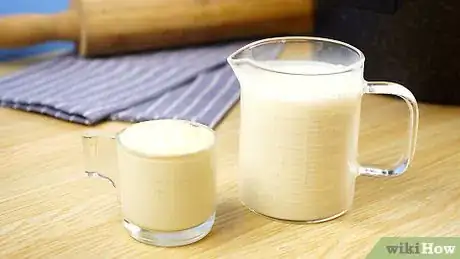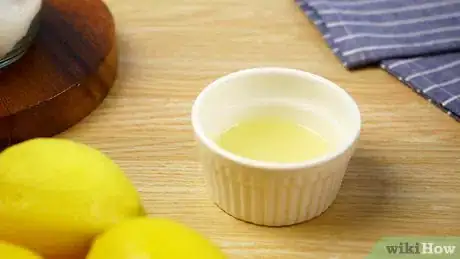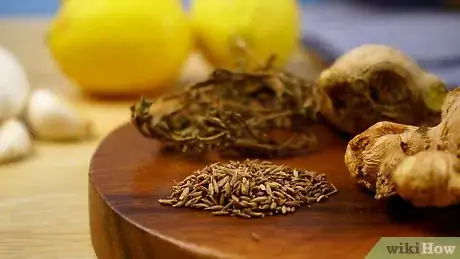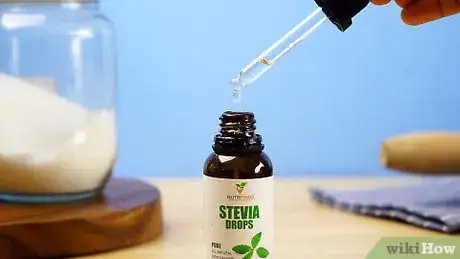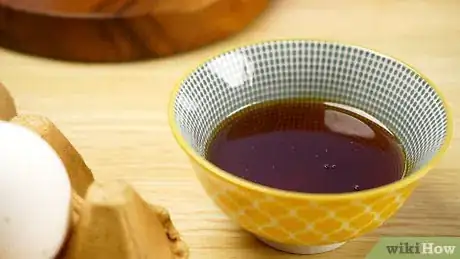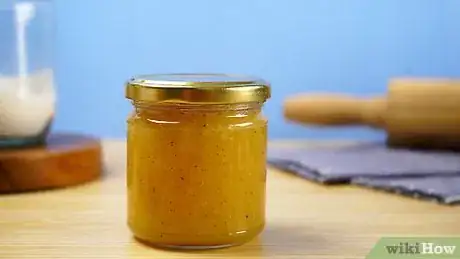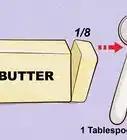This article was co-authored by Jillian Fae Downing. Jillian Fae Downing is a Private Event Chef, Chef Educator, and the Owner of Jillian Fae Chef Services based out of Temecula, California. With 12 years of experience, she specializes in menu planning and menu research and development. Jillian Fae holds an Associate of Science in Culinary Arts from Orange Coast College and a BA in Mass Communication and Media Studies from Arizona State University. She is also a member of the American Culinary Federation and the American Personal and Private Chef Association.
There are 7 references cited in this article, which can be found at the bottom of the page.
wikiHow marks an article as reader-approved once it receives enough positive feedback. In this case, 100% of readers who voted found the article helpful, earning it our reader-approved status.
This article has been viewed 179,595 times.
The key to a delicious meal is balancing flavors, so there's an equal amount of sweet, spicy, savory, bitter, sour, and salty. If your dish turns out too sweet, though, that doesn't mean it's destined for the trash. By tweaking the recipe or incorporating additional ingredients, you can get the balance just right, so the sweetness doesn't overpower the other flavors.
Steps
Diluting the Recipe
-
1Add more of the main ingredient(s). If you’ve added too much sugar, you can balance out the sweetness by incorporating more of another ingredient to help make the dish less sweet. The easiest way to dilute a recipe is to add more of the main ingredient, so the taste of the sugar isn’t as obvious.[1]
- If your tomato sauce is too sweet, try adding more tomatoes or tomato paste to counter the sugar.
- For a salad dressing that’s too sweet, mix in additional olive oil.
- If your chili is too sweet, you can add in some extra meat or beans to help balance the sweetness.
-
2Mix in water or stock. In some cases, incorporating a little extra liquid in a recipe can help balance out excessive sweetness. Water is an ideal choice because it is flavorless, so it will dilute the sugar without changing the taste of your dish. Chicken, beef, or vegetable stock is also an option if you don’t mind adding extra flavor to the dish.[2]
- Diluting a recipe with a liquid to balance the sweetness typically works best with dishes that already have a creamy or liquid-like consistency, such as soups and stews.
- If you plan to dilute with water or chicken stock, start with a small amount, so you can see how it affects the dish. You don’t only have to think about the taste, though -- consider the consistency too.
Advertisement -
3Blend in milk or cream. If you’re worried that water or stock will make your dish too thin or runny, dairy products such as milk, cream or half and half are an ideal alternative. They tend to have a thicker consistency, so they’ll keep your recipe creamy while balancing the sweetness.[3]
- Milk and cream can work well in soups, sauces, and casseroles.
- If you’re vegan or don’t eat dairy, non-dairy milks, such as almond, cashew, or soy, are a good alternative. Just make sure to choose an unflavored, unsweetened variety.
Adding Acids
-
1Stir in citrus juice. Citrus fruits have a fresh, tart taste that can balance out the sweetness in a recipe. If your dish is too sweet, squeeze in a little fresh juice to counter the excess sugar. It’s best to start with just a small amount, such as a teaspoon, so you don’t run the risk of making the food too tart instead of too sweet.[4]
- Lemon or lime juice works best when you want to balance a savory recipe that’s overly sweet.
- It’s a good idea to squeeze your citrus fruit into a cup or bowl instead of directly into the pot or pan. That way, you won’t accidentally let any seeds or pulp fall into your food.
- If citrus juice is too liquidy to add to your dish, lemon or lime zest can also add some tartness.
-
2Add vinegar. Like citrus fruits, vinegar is an acidic ingredient that can add tartness to a dish to help balance the sweetness. However, unlike fruits which can go bad quickly, you can keep a bottle of vinegar in your pantry for years, so you’ll always have it on hand if you add too much sugar to a dish. Start with just a splash or teaspoon and taste, so you can ensure that the recipe is balanced. You can always add more if necessary.
- Virtually any vinegar can help correct food that’s too sweet, but white, red wine, white wine, and apple cider usually work the best.
-
3Mix in wine. Adding a splash or teaspoon of wine to your recipe to balance the sweetness is similar to stirring in some vinegar because both are acidic and alcohol-based. However, wine has a higher alcohol content, so if you don’t want alcohol in your dish, bring the food to a boil to evaporate the alcohol.
- You can use cooking wine to help counter excess sweetness, but any wine that you would drink will work just as well.
Adding Spices
-
1Sprinkle in some pepper. Giving your dish a spicy kick can help tone down its sweetness, and pepper works really well to add some heat. Depending on the food and your personal tastes, you can use black, cayenne, or crushed red pepper to help balance the flavors in your recipe. A pinch is usually all it takes, but taste the dish to see if the sweetness has been adequately toned down.[5]
-
2Incorporate garlic. There’s a reason that so many recipes call for garlic -- it has a spicy distinctive taste that can help lessen the sweetness in a dish. Best of all, it’s versatile, so you can add it to sauces, meat, fish, vegetables, soups, stews, and casseroles that are too sweet.[6]
- Fresh garlic cloves have the strongest flavor, so they usually work best. However, garlic powder can be effective too. Start with 1 clove of garlic or ⅛ of teaspoon of the powder, and adjust to taste.
- Don’t cook the dish too long after you’ve added the garlic. It becomes sweeter the longer that you cook it, so you can actually wind up increasing the sweetness in your food.
-
3Stir in oregano, ginger, basil, cumin, or your favorite pungent spice/herb. Any spice that adds heat or a smoky, earthy flavor is ideal for countering excess sweetness, so choose an option that complements the dish that you’re making. Both fresh and dried spices can work, but start with a small amount and taste as you go.[7]
- Dried herbs and spices are stronger and more concentrated than their fresh counterparts, so you don’t need to use as much. Start with ⅛ of a teaspoon and add more if necessary after tasting.
- Other spices and herbs that you may want to consider for balancing sweetness include rosemary, sage, thyme, chili powder, and marjoram.
Adjusting the Recipe
-
1Lessen the amount of sugar. If you’re sensitive to sweetness, the amount that a recipe calls for may just be too much for you. In that case, feel free to tinker with the recipe and decrease the sugar that’s called for, so the sweetness is more balanced for your palate. For example, if the recipe suggests ¼ cup of sugar, try ⅛ cup instead.[8]
- If you’re not sure how to much to decrease the sugar by, start by adding a very small amount, such as a teaspoon, and then taste the dish. Add another teaspoon if it’s not sweet enough. It’s easy to add more sugar, but it’s harder to balance the sweetness once it’s already in the dish.
- If you're baking, it's obviously harder to taste cookies and cake as you go to adjust the sweetness. Sugar also affects the texture and moistness of baked goods, so you have to be careful when you adjust the amount in a recipe. Using 3/4 of the suggested sugar usually yields the best results, but you may want to make a batch of test cookies or cake to ensure that you're happy with the results.[9]
-
2Use a sugar substitute. Artificial sweeteners are usually sweeter than traditional white or brown, which means you don’t have to use as much of them in your recipes. That can help you have better control over the sweetness of your food. Sucralose, commonly sold as Splenda, and stevia, commonly sold as Truvia, are ideal for cooking and baking because it’s heat stable.
- Sucralose can be substituted for sugar in a 1:1 ratio, which means if your recipe calls for a 1/4 of sugar, you can replace it with a 1/4 of sucralose.
- Stevia is 200 times sweeter than sugar. Replace each cup of sugar with 1 teaspoon of stevia in your dishes. If the recipe calls for a tablespoon of sugar, an 1/8 of a teaspoon of stevia is all you need. A pinch of stevia can replace a teaspoon of sugar.
- Some sugar substitutes, such as Equal and Sweet’N Low, don’t react the same way as sugar does when they’re heated. It’s best to avoid them when cooking and baking.
-
3Substitute maple syrup. It contains natural sugars that can add a subtle sweetness to your dish, as well as antioxidants that are actually good for you. You can replace one cup of white sugar with 3/4 of a cup maple syrup.[10]
- For the best results, be sure to choose 100% pure, organic maple syrup. Grade A has a more subtle flavor, while Grade B has a stronger flavor and thicker texture so it works well in baking.
- If you're using maple syrup to replace sugar in baked goods, you'll need to adjust the overall amount of liquid in the recipe by approximately three tablespoons for every cup of maple syrup that you add.
-
4Add honey instead. Like maple syrup, honey can add a mellow, more wholesome sweetness to your recipes in place of sugar. However, it's sweeter than white sugar, so you don't need to add as much. For every one cup of sugar in a recipe, replace with 3/4 of a cup of honey.[11]
- In baking recipes, you'll need to reduce the overall liquid by approximately two tablespoons for every one cup of honey used.
- Baked goods made with honey tend to brown faster than those made with white sugar, so watch cookies, cakes, and other sweets carefully.
-
5Use agave nectar in place of sugar. Agave syrup has a lighter taste than maple syrup or honey, and its texture is thinner than honey but thicker than maple syrup. However, like the honey and maple syrup, it's all-natural, so it's good alternative to white sugar. Replace every cup of sugar in your recipe with 2/3 of a cup of agave nectar.[12]
- Because of its liquid consistency, you'll need to reduce the overall liquid in your recipe by 1/4 to 1/3 of a cup for every cup of agave used.
- Baked goods made with agave nectar have a tendency to brown more quickly, so you may want to reduce the baking temperature by 15 to 25 degrees.
-
6Incorporate applesauce in baked goods. Make your cookies, cakes, and other goodies a little less sweet by using the natural sugars in applesauce in place of white sugar. It's one of the easier replacements to make, too, because you can replace it cup for cup. That means if your recipe calls for two cups of sugar, you can substitute two cups of applesauce in its place.[13]
- Make sure to choose unsweetened applesauce when you're replacing sugar. Otherwise, your recipe may actually wind up too sweet.
- When you're baking with applesauce, you'll need to reduce the overall amount of liquid in the recipe by 1/4 of a cup for every cup of sauce used.
Expert Q&A
-
QuestionWhat are the different flavors you should try to balance in a dish?
 Jillian Fae DowningJillian Fae Downing is a Private Event Chef, Chef Educator, and the Owner of Jillian Fae Chef Services based out of Temecula, California. With 12 years of experience, she specializes in menu planning and menu research and development. Jillian Fae holds an Associate of Science in Culinary Arts from Orange Coast College and a BA in Mass Communication and Media Studies from Arizona State University. She is also a member of the American Culinary Federation and the American Personal and Private Chef Association.
Jillian Fae DowningJillian Fae Downing is a Private Event Chef, Chef Educator, and the Owner of Jillian Fae Chef Services based out of Temecula, California. With 12 years of experience, she specializes in menu planning and menu research and development. Jillian Fae holds an Associate of Science in Culinary Arts from Orange Coast College and a BA in Mass Communication and Media Studies from Arizona State University. She is also a member of the American Culinary Federation and the American Personal and Private Chef Association.
Private Event Chef & Chef Educator Dry to find a good balance of salt, fat, acid, and heat to to make your dish stand out.
Dry to find a good balance of salt, fat, acid, and heat to to make your dish stand out. -
QuestionHow can you reduce sweetness of fried onions?
 Community AnswerFrying an onion is going to make it sweeter, but you can control the amount of sweetness with the way that you cook it. To keep it from getting too sweet, fry it at a high heat for just a few minutes. If you lower the temperature and slow cook it, you'll caramelize the onion, which makes it very sweet.
Community AnswerFrying an onion is going to make it sweeter, but you can control the amount of sweetness with the way that you cook it. To keep it from getting too sweet, fry it at a high heat for just a few minutes. If you lower the temperature and slow cook it, you'll caramelize the onion, which makes it very sweet. -
QuestionI accidentally added sweetened condensed milk instead of evaporated milk to a macaroni and cheese recipe. Can I save the dish?
 Community AnswerNo, unfortunately there is no way to save the dish in this case. Luckily, macaroni and cheese is pretty easy to make, so I would suggest giving it another go!
Community AnswerNo, unfortunately there is no way to save the dish in this case. Luckily, macaroni and cheese is pretty easy to make, so I would suggest giving it another go!
References
- ↑ http://www.onegreenplanet.org/vegan-food/fix-common-seasoning-mistakes/
- ↑ http://www.onegreenplanet.org/vegan-food/fix-common-seasoning-mistakes/
- ↑ http://www.onegreenplanet.org/vegan-food/fix-common-seasoning-mistakes/
- ↑ http://www.onegreenplanet.org/vegan-food/fix-common-seasoning-mistakes/
- ↑ http://www.onegreenplanet.org/vegan-food/fix-common-seasoning-mistakes/
- ↑ http://www.onegreenplanet.org/vegan-food/fix-common-seasoning-mistakes/
- ↑ http://www.onegreenplanet.org/vegan-food/fix-common-seasoning-mistakes/
- ↑ http://www.thekitchn.com/cooking-without-recipes-unders-52508
- ↑ http://food52.com/blog/15831-is-it-possible-to-reduce-sugar-in-a-baking-recipe
- ↑ http://www.maplesyrupworld.com/pages/Replace-Sugar-with-Maple-Syrup-in-Your-Cooking.html
- ↑ http://dish.allrecipes.com/baking-with-sugar-and-sugar-substitutes/
- ↑ http://kblog.lunchboxbunch.com/2009/07/agave-syrup-101-why-its-healthy-sugar.html
- ↑ http://www.sujajuice.com/blog/5-baking-substitutes-that-dont-sacrifice-flavor/
About This Article
To balance sweetness, try adding a splash of something acidic, like citrus juice or vinegar, so that the tartness will lessen the sweet flavor. You can also add in spices such as black or cayenne pepper to tone down sweetness and add a spicy kick. If you don’t want to add in any other flavors, stir in extra water or stock to dilute your dish. Alternatively, add cream or milk so that the richness can mask a sweet taste. For tips on how to use alternative sweeteners that aren’t as sweet as sugar, read on!
